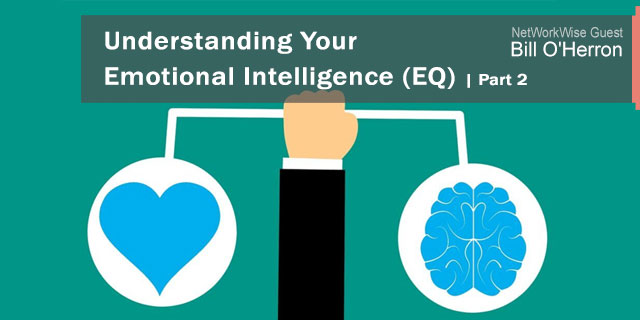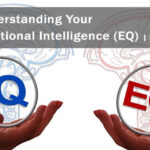This is Part 2 of a guest post by Bill O’Herron LCSW, Director of Capital Markets at Cygnus Capital, a successful alternative asset management firm based in Atlanta, GA (read Part 1 here)
EQ is a measure of one’s ability to understand their emotions. Given a commitment to working on EQ, it never stops evolving.
What we mean by understanding our feelings is that as the outside world stimulates internal reactions, as our boss, husband, wife, parent, child, client, or some stranger cutting us off in traffic generates a wave of emotions, we are capable of recognizing what is actually happening in us and able to take responsibility for how and what we do with these reactions.
Many people struggle with this though.
In fact, there is a “global deficit in understanding and managing emotions, only 36% of people when tested are able to accurately identify their emotions as they happen” (Travis Bradberry, Emotional Intelligence 2.0).
An example of a low EQ moment is when you are on a call with a big, prospective client and he starts challenging you about your product, competitive edge, and your skill set in general. Your deepest experience of self-worth is being activated and questioned as you feel your chest tighten.
But you recognize that though you are well versed in your field and in product knowledge, you could learn more, and this prospect is actually just reminding you to dig deeper into your career growth.
You also sense that there is a frustration in this other person, that maybe he is not feeling complete in his job, so he is expressing angst by trying to belittle you. We only do to others what we are doing to ourselves inside. That is EQ at work, watching and listening to our sensations and those wise, voice-like thoughts that wake us up to the true, multi-level reality of every situation.
It is not easy, but growth comes from separating the insightful content of every message we get from the often poor and uncomfortable delivery. Maturity and growth come from recognizing our experience of the message and what it can reveal of ourselves, and not hanging our emotional hat on those that hand us this information.
EQ only emerges though from allowing all our feelings to come up, in a quiet place, so that our left brain can become familiar with them.
When our feelings are too heated, they are no good to our IQ. But when we are able to slow down and open up the channel of our right brain to allow our deepest longings and desires, and feelings of joy, emptiness, and sadness to cross over into our left-brain perceptions, we begin to make sense of our reactions, of our inner child experiences. “The left brain takes an idea, information, or inspiration from the right brain and puts it into action…. dissolves fears, enhances experiences, opens new vistas, cleans out false beliefs” (Robert Monroe, Ultimate Journeys).
Without the left brain, our inner world and its cacophony of feelings and unprocessed childlike habits simply continue to dominate our personality. All the IQ in the world is no match for the adolescent reactions of grown men and women. The only way to develop and create this dialogue between the left and right brain is through sitting quietly, what many call meditation. I call it Listening By Yourself (LBY). “The communication between left and right brain is the physical source of EQ” (Travis Bradberry; Emotional Intelligence 2.0).
Let me say that again.
The only way to really begin the physical manifestation of bringing your two worlds together, which in turn will help you to slow your body down so that the language spoken by your rational self can comprehend the messages, information, and intelligence stored in the anger and joy of your feelings, is to sit quietly and listen to your inner world.
One of western civilizations’ greatest scientist minds, Blaise Pascal, a man who has a law, theorem, and coefficient solving triangle named after him, bluntly stated why we all struggle with full achievement, expression, and success in our lives, “all of humanity’s problems stem from man’s inability to sit quietly in a room alone”.
LBY helps to make sense of all that is nonphysical in our life, all that is amorphous, dreamlike, and seemingly unknowable within our hearts and bellies. Humans have been sitting for a long time. “A couple hundred-thousand years ago, early humans huddled around campfires to meditate and partake in shamanistic rituals…which strengthened the mind’s ability to connect symbols and meaning” (“Meditate on It”, Eric Jaffe, www.smithsonian.com).
When we sit quietly, after about 7-8 minutes our brain starts to secrete melatonin and serotonin, both relaxation hormones.
These hormones are actually released when we sleep. But when we sit, these natural relaxants begin to hit the bloodstream, which increases blood circulation which begins to dampen all the biochemical overactivity within the mid-brain (Dr. Dharma Singh Khalsa, Meditation as Medicine). As the wave frequency of the electrons throughout our brain slow down, a powerful shift takes place.
Shift Happens, notice the ‘f’!
What happens is that our left brain, which is normally in high alert and overworked as it seeks to keep the incessant overcharged, unconscious, and emotion-infused data in our limbic body from intruding into its neatly framed space and world, begins to open up. The physical relaxing and increase in blood flow stimulate a physiological response in our normally guarded left brain, which in turn creates a psycho-emotional shift as the left brain is able to take in and ruminate on the feelings bubbling up. This is when and where our two worlds collide, merge, and begin knowing each other better.
The more you sit, the more your old feelings from 5th or 10th grade will come, sensations of loss and joy that you forgot were in there. If you get serious about your life, career, and growth, and embrace this practice of sitting, you will likely, out of nowhere, begin to laugh, cry, scream, jump around, and in general give voice and expression to that which has been stored in our midbrain, memory database the whole time.
There is nothing new in these expressions.
They are only new and foreign to your adult brain that has been avoiding these sensations since 7th grade. Eckhardt Tolle, probably the world’s biggest, most successful proponent of sitting quietly says this, “The primary cause of unhappiness is never the situation but your thoughts about it” and “Some changes look negative on the surface but you will soon realize that space is being created in your life for something new to emerge.”
Allowing what is already in you like joy, tears, anger, etc. might feel strange and seem negative to the thinking, serious, reserved, and the self-conscious adult part of you. But how can you trust, know, empathize, and connect deeply with others if you do not do so with yourself?
You will bring an adult sensibility and care to all the adolescent reaction patterns still actively living inside.
You will do all of this in a safe spot, and you might add some kind of therapeutic counseling to these exercises. Either way, the birth of your deepest awareness and fullest expression of your emotional intelligence will only be truly be realized by the union and conscious reunion of your left and right brains.
Nike said, “Just do it”. We say, “Just sit it” and get to the work of knowing oneself.









